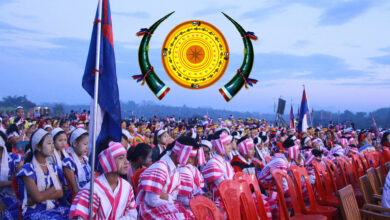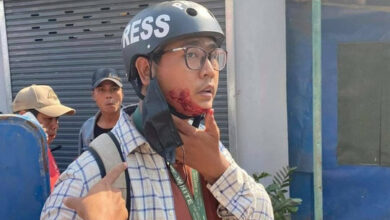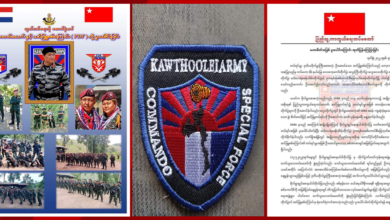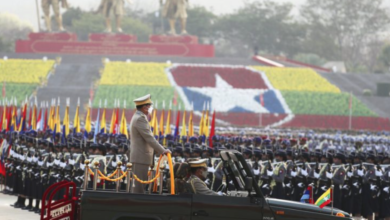KNU Needs a Strong, Charismatic and Unifying Leader to Maintain Unity and Contain Dissension

The recent development within the KNU’s leadership has sent viral shock wave across the Karen communities both inside and abroad. The revelation that KNLA’s top leader, some brigade commanders, district officials and KNU Central committees journeyed to Pan-An to open a liaison office without KNU’s approval and the subsequent dismissal of three senior members, including the commander-in-chief, has made Karen communities puzzled and wondered how could this be while the Karen struggle is at a crossroad and critical stage.
Some wonder has the KNU’s leadership not learned from past mistakes and weakness when they deal with the government, especially when it comes to ceasefire matter? Or have they not been able to compromise and become politically matured? Some point fingers at the opportunists and self-centered individuals within the leadership rank while others blame the Burmese government’s insincerity and cunning tactic to drive a wedge between the Karen leadership. But as one talk about the issue, the questions only keep rolling and there seems to be no satisfactory answers, or maybe there are too many answers.
Some people talk about ideological division and different tactic persist within the KNU’s leadership as to how they should approach the ceasefire issues. It’s rumoured, with little facts, that some individuals within the leadership want to adopt a hard line position and prefer a cautious approach to deal with the ceasefire while others want to see a bold and faster move to struck a deal. But, if it’s anything else, the dissension and crack only remind me of 2006, the year the late KNU’s leader Gen. Saw Bo Mya passed away and the subsequent split from the KNU of KNLA’s brigade 7 led by Gen. Htay Maung. Before Gen. Saw Bo Mya passed away, of course there were already sings of disarray in KNU’s leadership. With opportunists in his inner circles and some bad advisers, Gen. Htay Maung was known to be very enthusiastic and active to secure a peace deal with the former Burmese military government at the time when the majority of the KNU’s leadership had doubt and was against it. He was essentially counting on Gen. Saw Bo Mya’s blessing and hoped that he could convince him to go ahead and forge a peace deal with the government.
But Gen. Saw Bo Mya was not someone to be crossed, tricked and pushed around easily by his subordinates. He had been cautious and known what he was dealing with, even in his ailing and dying moment. He refused a medical treatment offered by the Burmese government in Bangkok under the arrangement of Gen. Htay Maung and his colleagues. He understood that the medical treatment being offered had a hidden message that was more than a gesture of goodwill toward him. Finally, through his influence and personality, he was able to calm the situation-and for a little while- restrain Gen. Htay Maung and his followers. But as soon as he passed away the crack started showing again when Myat Htun Oo- then a post-Khin Nyut military intelligent officer- show up at Gen. Saw Bo Mya’s funeral out of nowhere without the prior knowledge of the KNU’s leaders. And not too long after that, Gen. Htay Maung and his troops would already be in Htook Kaw Ko, his new base given by his friend, the military government. In hind sight, it is fair to say that Gen. Htay Maung was only waiting for his time-the passing of Gen. Saw Bo Mya-so that he could do what he wanted. Most Karen people seem to agree that had Gen. Saw Bo Mya not passed away, Gen. Htay Maung would not have gotten his way.
The recent split and disagreement within the KNU’s leadership has reminded us and reinforce the need for a strong, charismatic, unifying and decisive leader to prevent, contain, and put off fire in a divided house. As American’s president Abraham Lincoln said, ‘A house divided against itself can not stand.’ To put of the fire and prevent the Union from collapsing and disintegrating between North and South, Lincoln had to act swift and decisive, but with courage and charisma. But the problem we are facing today is KNU has no Lincoln. Ever since the Karen revolution was launched in 1949-that is more than 60 years ago-the KNU has had many leaders at it’s helm. But of those many leaders, not many of them were so influential and charismatic that they could control the organization, inspire the Karen movement, and leave a lasting mark and memory in Karen political history, especially among the ranks and files soldiers and ordinary Karen people. But this is not to suggest that those who weren’t influential weren’t smart or good leaders. Indeed they were all as good and smart. But in terms of charisma, influence and strong personality, it’s fair to say that only Saw Ba Oo Gyi and Gen. Saw Bo Mya stood out.
The reason is because they were the two leaders who have shaped the Karen political course, unified the leadership and inspired the Karen movement. More than half a century later almost all Karen people, from the highest to lowest spectrum of life, still remember Saw Ba Oo Gyi and know him. He was instrumental in laying the foundation for Karen revolution and the most influential and well known leader in the Karen political history. He is still in the memories of almost all Karen people. His principles are still worshiped and firmly adopted by all Karen groups regardless of their political, religion, ideology, and linguistic orientation. This is a testament to his power, charisma, and personality. But his early and untimely death cut short his work and tremendous contributions he would make to the Karen’s revolution. Gen. Saw Bo Mya may not be as well known and respected as Saw Ba Oo Gyi, but he is still widely known, respected and regarded by most Karen people as a unifying figure because of his strong personality, bravery, and warrior status. Most Karen people know his name when you mention him. He was feared by both friends and foes alike. It’s joked that in his heyday he could even scare New Win through his fart 3000 miles away. For three decades, he was the de facto leader of armed opposition groups and New Win’s arch rival in Burma political movement. Under his leadership, Manerplaw was an equivalent of Rangoon for most Burmese oppositions and ethnic groups that took up arms against the military government. He was also widely known and respected by alliances and ethnic armed groups. He had a reputation for being strong, decisive and swift in taking action.
Thus, his subordinates rarely crossed him and uttered any dissension under his leadership. His strong personality may be tarnished by the break up of the KNU in 1994 that led to the formation of DKBA, but the split was not instigated at the top leadership, instead it was a bottom-up initiative. Even so, it was suggested that had his order being heeded and followed through accordingly, the outcome would have been different and the split could have been prevented.
For any revolution or political organization to unite and succeed, strong leadership is as much important as mass support. Historically, most successful revolutions have popular figures and leaders with charismas and strong personalities to inspire people, mobilize public support and unite the ranks and files. China had Sun Yat Sen to unite the Chinese under one banner and liberate them from the Manchu’s rule. Mao Tse Tung was a larger-than-life political figure to take the Chinese Communist Party to victory. Cuban had Castro, Indonesia had Sukarno, Vietnam had Ho Chi Min, America had George Washington, South Africa had Nelson Mandela and Burma had Aung San. Most of these leaders have more or less single-handily led their people to victory based on their charismas, strong personalities and respected status. Through their charismas and strong personalities, they were able to inspire people, mobilize public support, and maintain unity within their organizations.
However, in comparison to the current Karen political movement, it’s fair to say that the Karen leadership lacks most of the essential and necessary attributes to inspire Karen people, unify the ranks and files and mobilize public support. There is no individual figure in current KNU’s leadership who could inspire Karen people, bring them together and hold the organization tight. Ever since the passing of Gen. Bo Mya in 2006, Karen people haven’t been able to identify any strong, unifying and influential leader who could hold the KNU’s leadership together. Besides, most contemporary Karen people don’t even know who leads the KNU and the current Karen political movement, let alone understanding it’s policy, vision and strategy. Only a minority of Karen people, especially those who pay attention to Karen struggle and are close to the KNU, would know where the organization is heading to. I once asked a high ranking district officer and a military commander how they are connected to the central leadership and what are some of the visions and strategies the KNU has in place but none of them seemed to have a clue. Their reply was ‘We don’t know where the central leadership is up to and what the long-term plans are in the next five or ten years.’ When asked who should lead the KNU and be an effective and strong leader the answer was the same-they couldn’t point to anyone with that qualities in the current leadership who would have the majority support and unite the Karen people. Consequently, in the absence of a strong and connected leadership, most ranks and files and local communities would turn to local leaders who are familiar to them. Factionalism and open revolt within the leadership would emerge and effectively undermine the central authority.
The current dissension and division within the KNU has as much to do with strong leadership as it has with ideological difference and personal interests. Of course every organization has its ideological difference, but when a strong and popular leadership is in place the ranks and files rarely dare or would want to revolt. And as long as the KNU lacks a strong, charismatic, articulate, unifying and popular leader, the organization will continue to see and experience dissension, fragmentation, and factionalism so long as the Karen revolution continues to exist.
*Saw Greh Moo is a Karen analyst based in Canada. His opinion does not reflect that of Karen News’. He can be reached by email at grehmoo@hotmail.com.




